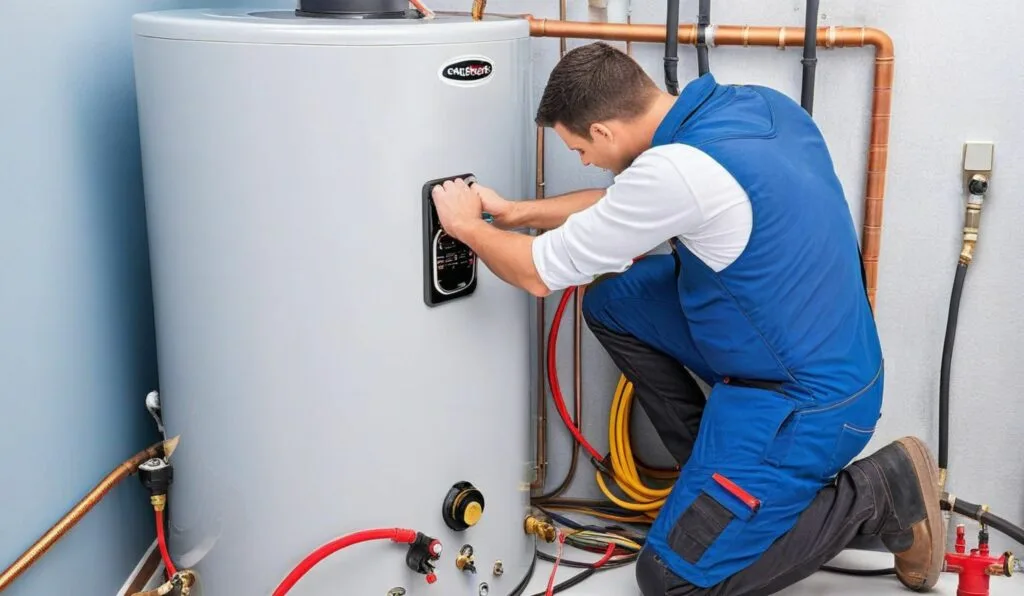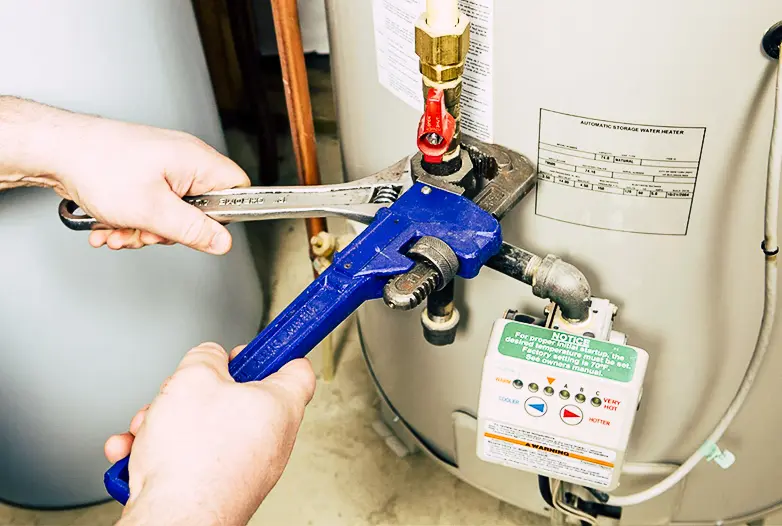
When your hot water system decides to quit on you, it can feel like a disaster. No one likes cold showers or washing dishes with icy water. But, don’t worry—many hot water system repair issues can be tackled without needing a professional immediately. Let’s dive into how you can handle hot water system repairs like a pro.
Hot water is a modern convenience we often take for granted—until it’s gone. Learning how to handle common hot water system repairs can save you time, money, and a lot of frustration. This guide will walk you through understanding your hot water system, diagnosing problems, and performing basic repairs. Plus, we’ll know when it’s time to call in the professionals at SJS Plumbing, Caroline Springs.
Understanding Your Hot Water System
Before you can fix a problem, you need to understand what you’re dealing with. Most homes have one of three types of hot water systems: electric, gas, or solar.
Electric Systems
Electric systems use electricity to heat water stored in a tank. They’re common in areas where natural gas is not available.
Gas Systems
Gas systems heat water with a gas burner. They tend to be more energy efficient than electric systems and can provide hot water even during power outages.
Solar Systems
Solar systems use energy from the sun to heat water. They’re environmentally friendly and can significantly reduce your energy bills, but they often come with a higher upfront cost.

Common Issues and Troubleshooting
Hot water systems, like all appliances, can develop issues over time. Here are some common problems and how you can troubleshoot them.
1. No Hot Water
If you’re not getting any hot water, the problem could be with the power supply, thermostat, or heating elements.
- Electric Systems: Check if the circuit breaker has tripped. Reset it if necessary. If the breaker is fine, the thermostat or heating element may need replacement.
- Gas Systems: Ensure the pilot light is lit. If it’s out, follow the manufacturer’s instructions to relight it. If it won’t stay lit, you might have a problem with the thermocouple or gas valve.
- Solar Systems: Check if the backup heater is working. If the solar panels aren’t providing enough heat, the backup system should kick in.
2. Insufficient Hot Water
If your water isn’t getting hot enough, it might be due to:
- Electric Systems: The thermostat may need adjusting. Set it to 60°C for optimal performance.
- Gas Systems: The burner could be dirty or malfunctioning. Clean it and ensure it’s working correctly.
- Solar Systems: The solar collector might be shaded or dirty. Make sure it’s clean and receiving adequate sunlight.
3. Water Leaks
Leaks are a common issue and can cause significant damage if not addressed promptly.
- Check Connections: Inspect all the connections to and from the tank. Tighten any loose fittings.
- Pressure Relief Valve: This valve releases water to reduce pressure in the tank. If it’s leaking, it might need replacing.
- Tank Issues: If the tank itself is leaking, it usually means it’s corroded and needs replacing.
4. Strange Noises
Banging, gurgling, or popping sounds are indicators of sediment build-up or other issues.
- Sediment Build-Up: Drain the tank to remove sediment. This is a common issue in areas with hard water.
- Heating Element: Electric systems may have a faulty heating element. Inspect and replace if necessary.
5. Discoloured Water
Rusty or discoloured water can be a sign of corrosion inside the tank.
- Anode Rod: Check the anode rod. This rod prevents tank corrosion but needs replacing every few years.
- Tank Corrosion: If the tank is corroded, it’s time for a new one.
Tools You Might Need
Having the right tools makes any repair job easier. Here’s a basic list of tools you might need for hot water system repairs:
- Adjustable wrench
- Screwdrivers
- Multimeter (for electrical systems)
- Pipe tape
- Plumber’s tape
- Bucket (for draining the tank)
- Garden hose (for draining the tank)
- Replacement parts (thermostats, heating elements, anode rods, etc.)
Safety First
Safety should always be your top priority when working with hot water systems. Here are some essential safety tips:
- Turn Off Power: Always turn off the power supply before working on electric systems.
- Turn Off Gas: For gas systems, turn off the gas supply.
- Water Supply: Turn off the water supply to prevent flooding.
- Safety Gear: Wear gloves and safety glasses to protect yourself from hot water and sharp edges.
- Follow Manufacturer Instructions: Always follow the manufacturer’s guidelines and instructions.
Step-by-Step Repair Guide
Here’s a step-by-step guide for some common hot water system repairs.
Replacing a Thermostat or Heating Element (Electric Systems)
- Turn Off Power: Turn off the circuit breaker.
- Drain the Tank: Attach a garden hose to the drain valve and empty the tank.
- Remove Access Panels: Unscrew and remove the access panels.
- Disconnect Wiring: Note the wiring connections and disconnect them.
- Remove the Component: Unscrew the thermostat or heating element and remove it.
- Install New Component: Install the new part, reconnect the wiring, and reassemble the access panels.
- Refill the Tank: Close the drain valve, turn on the water supply, and refill the tank.
- Restore Power: Turn the circuit breaker back on.

Relighting the Pilot Light (Gas Systems)
- Turn off the gas: Turn off the gas supply.
- Access the Pilot: Remove any access covers to reach the pilot light.
- Light the Pilot: Follow the manufacturer’s instructions to light the pilot. This usually involves turning the gas control knob to the pilot position, holding it down, and using a lighter.
- Hold the Knob: Keep the knob depressed for a minute after lighting.
- Turn Gas On: Turn the gas supply back on and replace the access covers.
Draining the Tank
- Turn Off Power/Gas: Turn off the power or gas supply.
- Turn Off Water Supply: Close the cold water inlet valve.
- Attach a Hose: Connect a garden hose to the drain valve.
- Open the Valve: Open the drain valve and let the water flow out.
- Flush the Tank: Open the cold water inlet to flush out the remaining sediment.
- Close Valves: Close the drain valve and disconnect the hose.
- Refill the Tank: Open the cold water inlet and refill the tank.
- Restore Power/Gas: Turn the power or gas supply back on.
When to Call a Professional
While many repairs can be handled on your own, some situations require a professional touch. Call a professional if:
- You’re not comfortable performing the repair.
- You suspect a gas leak.
- The tank is severely corroded or leaking.
- You’ve tried DIY fixes, and the problem persists.
- You need a new hot water system installed.
Why Call SJS Plumbing?
Even for seemingly simple fixes, there are advantages to calling a professional plumber:
- Expertise: We have the experience and knowledge to diagnose the problem quickly and accurately.
- Safety: Our plumbers are licensed and insured, ensuring your safety and the proper handling of gas and electrical components.
- Efficiency: We have the right tools and experience to get the job done quickly and efficiently, minimising disruption to your hot water supply.
- Preventative Maintenance: We can also recommend and perform preventative maintenance to avoid future problems and extend the lifespan of your hot water system.
SJS Plumbing: Your Local Hot Water System Repair Experts
Handling hot water system repairs like a pro doesn’t have to be daunting. With the right knowledge, tools, and a bit of patience, you can troubleshoot and fix many common problems yourself. However, always prioritise safety and know when it’s time to call in the professionals. If you need expert help in hot water system repair in Caroline Springs, SJS Plumbing is just a call away.
FAQs
1. How often should I service my hot water system?
It’s recommended to service your hot water system every 1-2 years to ensure it runs efficiently and lasts longer.
2. What temperature should I set my thermostat to?
The ideal temperature for your hot water system is around 60°C. This prevents scalding and conserves energy.
3. Why is my hot water system making strange noises?
Strange noises often indicate sediment build-up in the tank. Draining and flushing the tank can resolve this issue.
4. Can I replace the heating element myself?
Yes, with the right tools and safety precautions, you can replace the heating element in an electric system.
